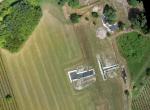Summary (English)
Further confirmation regarding the hypothesis about the position of Aquileia’s Roman theatre in correspondence with the State owned ex Comelli-Moro property was provided by the 2016 excavations. Indeed, the fieldwork, both geophysical survey and excavation, made it possible to define the presence of a monumental Roman building (not yet dated by stratigraphical evidence), characterised by a succession of long, substantial radial walls, arranged alternately in two concentric rows divided by an intermediate curved wall. Considering the particular characteristics of the radial structures’ plan and dimensions, they can probably be identified as the substructures for the theatre’s cavea.
The stratigraphic excavations were concentrated in four trenches: two extending those opened in 2015 (trenches 1 and 2), and two new ones (trenches 3 and 4). In trenches 3 and 4, two base blocks from the terminal pillars of the respective radial walls were found, their position making it possible to define the perimeter of the cavea. In trenches 1 and 4, a series of overlying beaten floor surfaces were exposed relating to the area outside the building. This area appeared delimited by an enclosure that followed the theatre’s curved line.
In addition to these Roman structures, only partially preserved because cut by widespread robbing of the building materials, there were interesting stratigraphic sequences relating to the use of the building for large scale dumping of metal working waste, stone and marble fragments in the late antique and early medieval periods. Further build-ups of material attest the later occupation of the area in the post antique period. The robbing episodes appeared quite recent.
- Andrea Raffaele Ghiotto Università degli Studi di Padova - Dipartimento dei Beni Culturali
Director
Team
- Mattia Teo - Università di Padova, Dipartimento dei Beni Culturali
- Simone Berto- Università di Padova, Dipartimento dei Beni Culturali
- Rita Deiana- Università di Padova, Dipartimento dei Beni Culturali
- Giulia Fioratto- Università degli Studi di Padova - Dipartimento dei Beni Culturali
- Guido Furlan- Università di Padova, Dipartimento dei Beni Culturali
- Anna Riccato- Università di Padova, Dipartimento dei Beni Culturali
- Valentina Zanus Fortes - Università di Padova, Dipartimento dei Beni Culturali
Research Body
- Università di Padova
Funding Body
- Fondazione Aquileia






![Download [PDF]](/excavation/skins/fasti/images/results/download_sml.png)